
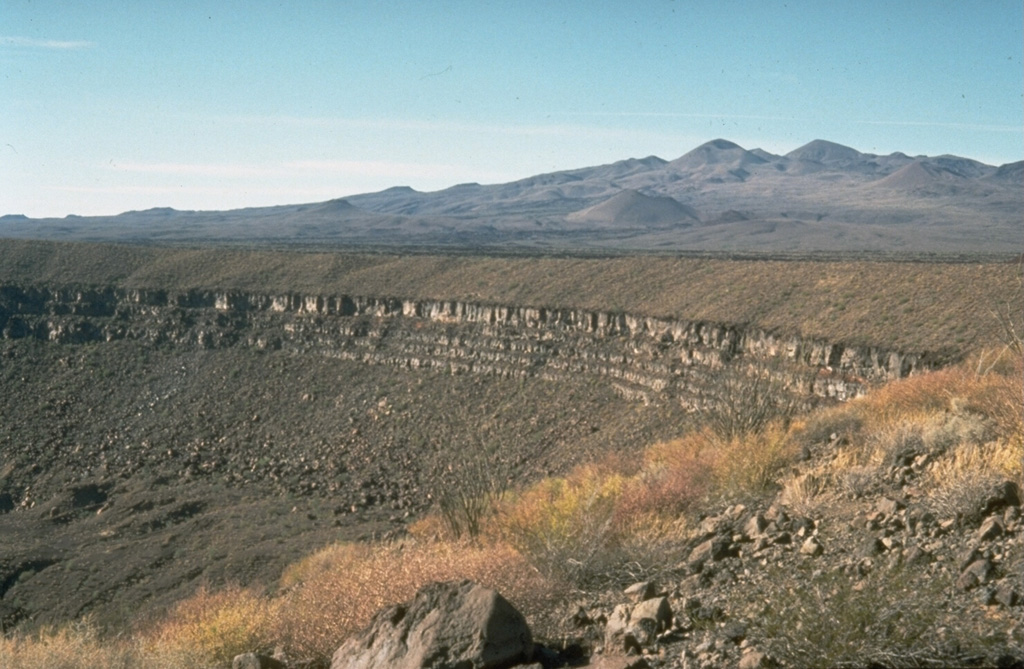
The Global Volcanism Program has no activity reports available for Pinacate.
The Global Volcanism Program has no Weekly Reports available for Pinacate.
The Global Volcanism Program has no Bulletin Reports available for Pinacate.
This compilation of synonyms and subsidiary features may not be comprehensive. Features are organized into four major categories: Cones, Craters, Domes, and Thermal Features. Synonyms of features appear indented below the primary name. In some cases additional feature type, elevation, or location details are provided.
Synonyms |
||||
| Santa Clara | Pinacate Peaks | ||||
Cones |
||||
| Feature Name | Feature Type | Elevation | Latitude | Longitude |
| Carnegie Volcano | Pyroclastic cone | |||
| Chivo, Cerro el | Cone | 330 m | 31° 46' 5" N | 113° 36' 58" W |
| Pinacate Peak | Cone | 1183 m | 31° 46' 21" N | 113° 29' 57" W |
| Santa Clara | Shield volcano | 988 m | 31° 46' 4" N | 113° 29' 28" W |
| Tecolote | Pyroclastic cone | |||
Craters |
||||
| Feature Name | Feature Type | Elevation | Latitude | Longitude |
| Badillo Crater | Maar | 31° 58' 0" N | 113° 34' 27" W | |
| Caravajales Crater | Crater | 31° 54' 45" N | 113° 41' 35" W | |
| Celaya Crater | Maar | 31° 59' 1" N | 113° 26' 47" W | |
| Colorado, Cerro | Maar | 31° 54' 53" N | 113° 18' 0" W | |
| Cuates, Cerro los | Crater | 31° 55' 0" N | 113° 40' 0" W | |
|
Elegante, Crater
Volcán el Elegante |
Maar | 320 m | 31° 50' 40" N | 113° 23' 28" W |
| Elena, Crater | Crater | 31° 57' 40" N | 113° 28' 23" W | |
| Jarapena, Volcan la | Crater | 31° 59' 0" N | 113° 46' 0" W | |
| Kino Crater | Maar | 31° 58' 58" N | 113° 30' 33" W | |
|
Luna, Crater la
Moon Crater Volcan la Luna |
Crater | 31° 45' 15" N | 113° 41' 10" W | |
|
Macdougal
Verdugo, Volcán el |
Maar | 240 m | 31° 58' 22" N | 113° 37' 35" W |
| Molina Crater | Maar | 31° 57' 40" N | 113° 36' 45" W | |
| Pastoria, Cerro la | Crater | 32° 0' 0" N | 113° 40' 0" W | |
|
Romo, Volcan
Tinaja de los Papagos |
Maar | 390 m | 31° 56' 0" N | 113° 34' 5" W |
| Sykes | Maar | 31° 56' 15" N | 113° 34' 5" W | |
| Tinajita, Volcan el | Maar | 280 m | 31° 58' 16" N | 113° 34' 26" W |
| Trebol, Volcan el | Crater | 250 m | 31° 57' 43" N | 113° 36' 47" W |
| Verdugo, Volcan el | Maar | 250 m | 31° 58' 34" N | 113° 37' 34" W |
| Vidrios, Volcan los | Maar | 280 m | 31° 59' 2" N | 113° 26' 46" W |
|
|
||||||||||||||||||||||||||||
There is data available for 0 confirmed Holocene eruptive periods.
[ 1934 Dec 31 - 1935 Jan 2 (?) ] Uncertain Eruption
| Episode 1 | Eruption | ||||||||||||||||||||
|---|---|---|---|---|---|---|---|---|---|---|---|---|---|---|---|---|---|---|---|---|
| 1934 Dec 31 - 1935 Jan 2 (?) | Evidence from Unknown | |||||||||||||||||||
|
List of 2 Events for Episode 1
| ||||||||||||||||||||
[ 1928 Jun 9 ] Uncertain Eruption
| Episode 1 | Eruption | ||||||||||||||||||||
|---|---|---|---|---|---|---|---|---|---|---|---|---|---|---|---|---|---|---|---|---|
| 1928 Jun 9 - Unknown | Evidence from Unknown | |||||||||||||||||||
|
List of 2 Events for Episode 1
| ||||||||||||||||||||
There is no Deformation History data available for Pinacate.
There is no Emissions History data available for Pinacate.
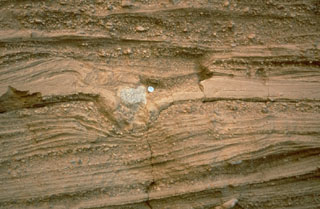 Pyroclastic surge deposits surround the Cerro Colorado maar of the Pinacate volcanic field in NW México. These thin beds (note the coin for scale) were formed by successive explosions that produced pyroclastic surges. The light-colored rock in the center of the photo is a ballistic block that impacted the surface of earlier surge deposits, compressing them and forming a small pit called a bomb sag.
Pyroclastic surge deposits surround the Cerro Colorado maar of the Pinacate volcanic field in NW México. These thin beds (note the coin for scale) were formed by successive explosions that produced pyroclastic surges. The light-colored rock in the center of the photo is a ballistic block that impacted the surface of earlier surge deposits, compressing them and forming a small pit called a bomb sag.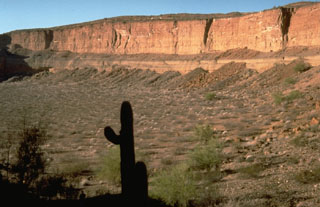 The Cerro Colorado maar, in the Pinacate volcanic field 24 km NE of Pinacate Peak, contains a 1-km-wide crater formed by explosions on a nearly flat surface. Distribution of ejecta by prevailing winds produced a hill on the side of the crater opposite this steep, 110-m-high crater wall. The ejecta include fragments of underlying granitic and metamorphic rocks.
The Cerro Colorado maar, in the Pinacate volcanic field 24 km NE of Pinacate Peak, contains a 1-km-wide crater formed by explosions on a nearly flat surface. Distribution of ejecta by prevailing winds produced a hill on the side of the crater opposite this steep, 110-m-high crater wall. The ejecta include fragments of underlying granitic and metamorphic rocks. The Pinacate volcanic field covers approximately 55 x 60 km and contains numerous maars and scoria cones. The field is prominent in this arid region of NW México near the head of the Gulf of California. The crater rim across the center of the photo is the 1.6-km-wide Cráter Elegante maar. Pinacate Peak in the distance is at the summit of Santa Clara shield volcano, which contains many scoria cones and lava flow fields.
The Pinacate volcanic field covers approximately 55 x 60 km and contains numerous maars and scoria cones. The field is prominent in this arid region of NW México near the head of the Gulf of California. The crater rim across the center of the photo is the 1.6-km-wide Cráter Elegante maar. Pinacate Peak in the distance is at the summit of Santa Clara shield volcano, which contains many scoria cones and lava flow fields.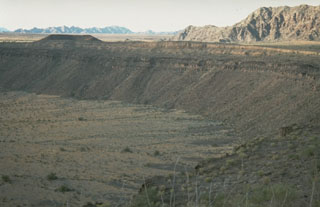 McDougal Crater, one of many Quaternary maars in the Pinacate volcanic field, formed within darker lava flow units near the top of the crater wall. Lighter-colored pyroclastic surge deposits form the crater rim and playa deposits formed on the crater floor. Crystalline rocks of the Sierrita el Temporal range are visible beyond the upper right crater rim to the north.
McDougal Crater, one of many Quaternary maars in the Pinacate volcanic field, formed within darker lava flow units near the top of the crater wall. Lighter-colored pyroclastic surge deposits form the crater rim and playa deposits formed on the crater floor. Crystalline rocks of the Sierrita el Temporal range are visible beyond the upper right crater rim to the north. McDougal crater on the NW side of the Pinacate Volcanic Field in NW México is the largest maar at Pinacate. This view from the SE looks across the 1,520 x 1,740 m wide crater, which contains playa deposits 130 m below the rim. The maar erupted through flat-lying alluvial terrain of the Gran Desierto.
McDougal crater on the NW side of the Pinacate Volcanic Field in NW México is the largest maar at Pinacate. This view from the SE looks across the 1,520 x 1,740 m wide crater, which contains playa deposits 130 m below the rim. The maar erupted through flat-lying alluvial terrain of the Gran Desierto. A large ejected block lies on the rim of Trebol maar in the NW part of the Pinacate volcanic field, immediately SE of Macdougal maar. The scale in front of the block has dark- and light-colored bars that mark 10 cm increments. The block fractured into three large segments following impact.
A large ejected block lies on the rim of Trebol maar in the NW part of the Pinacate volcanic field, immediately SE of Macdougal maar. The scale in front of the block has dark- and light-colored bars that mark 10 cm increments. The block fractured into three large segments following impact.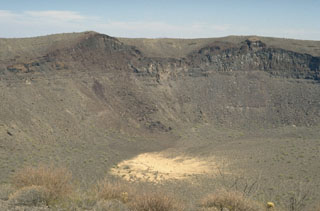 The SE wall of Cráter Elegante reveals a cross-section of a scoria cone that existed prior to explosive formation of the maar. The light-gray remnants of the sill intrusions are visible at the low point of the cone and below its right flank. The vent was located where the SE part of Cráter Elegante is now. The surface of the cone is mantled by pyroclastic surge deposits from the maar-forming eruption.
The SE wall of Cráter Elegante reveals a cross-section of a scoria cone that existed prior to explosive formation of the maar. The light-gray remnants of the sill intrusions are visible at the low point of the cone and below its right flank. The vent was located where the SE part of Cráter Elegante is now. The surface of the cone is mantled by pyroclastic surge deposits from the maar-forming eruption. A geologist stands on the irregular surface of a lava flow north of Volcán la Morusa, near Cerro Colorado. The flow is one of many young sparsely vegetated basaltic lava flows of the Pinacate volcanic field. Flow morphologies remain pristine for long periods of time in this arid region.
A geologist stands on the irregular surface of a lava flow north of Volcán la Morusa, near Cerro Colorado. The flow is one of many young sparsely vegetated basaltic lava flows of the Pinacate volcanic field. Flow morphologies remain pristine for long periods of time in this arid region. Cráter Elegante is one of the largest maars of the Pinacate volcanic field, seen here from the WSW. The uneven area on the southern crater rim (to the right) is a scoria cone that was dissected during formation of the maar. Another darker scoria cone to the right is surrounded by lighter-colored pyroclastic surge deposits from the maar-forming eruptions. A third scoria cone (lower left) opens toward the rim of Cráter Elegante and is partially surrounded by the younger dark-colored lava flow in the foreground.
Cráter Elegante is one of the largest maars of the Pinacate volcanic field, seen here from the WSW. The uneven area on the southern crater rim (to the right) is a scoria cone that was dissected during formation of the maar. Another darker scoria cone to the right is surrounded by lighter-colored pyroclastic surge deposits from the maar-forming eruptions. A third scoria cone (lower left) opens toward the rim of Cráter Elegante and is partially surrounded by the younger dark-colored lava flow in the foreground. Cráter Elegante, seen here in an aerial oblique view from the NW, is a 1.6-km-wide maar in the Pinacate volcanic field. Within the crater walls are exposed basaltic lava flows, sills, and dikes pre-dating formation of the maar, which are overlain by pyroclastic surge deposits that cover the rim and outer flanks. Lake beds within the maar have been radiocarbon dated at between about 13,000 and 17,000 years, indicating a late-Pleistocene age for the maar-forming eruptions.
Cráter Elegante, seen here in an aerial oblique view from the NW, is a 1.6-km-wide maar in the Pinacate volcanic field. Within the crater walls are exposed basaltic lava flows, sills, and dikes pre-dating formation of the maar, which are overlain by pyroclastic surge deposits that cover the rim and outer flanks. Lake beds within the maar have been radiocarbon dated at between about 13,000 and 17,000 years, indicating a late-Pleistocene age for the maar-forming eruptions.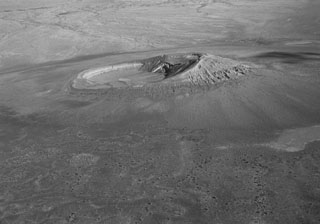 Cerro Colorado tuff cone is one of the most prominent features of the Pinacate volcanic field in Mexico. This aerial oblique view from the NW shows the 1-km-wide crater with the highest point on the S rim. Tuff beds that compose the S rim dip inward up to 20-25 degrees. Cerro Colorado's crater was formed during several episodes of phreatomagmatic eruptions from multiple vents, during which portions of the tuff cone slumped into the crater.
Cerro Colorado tuff cone is one of the most prominent features of the Pinacate volcanic field in Mexico. This aerial oblique view from the NW shows the 1-km-wide crater with the highest point on the S rim. Tuff beds that compose the S rim dip inward up to 20-25 degrees. Cerro Colorado's crater was formed during several episodes of phreatomagmatic eruptions from multiple vents, during which portions of the tuff cone slumped into the crater.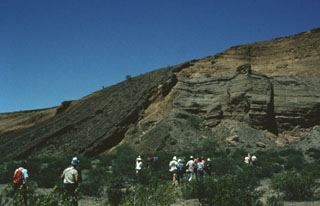 Participants in a geological field excursion examine the stratigraphy within the Cerro Colorado maar. The outcrop exposes a variety of deposits produced by several episodes of phreatomagmatic activity. The south crater walls here reveal layered tuff deposits and material from the collapse of the inner crater wall into the vent. Steeply dipping dark-colored tuff beds (left) can be traced from the crater floor up and over the walls, and then down the outer flanks of the cone.
Participants in a geological field excursion examine the stratigraphy within the Cerro Colorado maar. The outcrop exposes a variety of deposits produced by several episodes of phreatomagmatic activity. The south crater walls here reveal layered tuff deposits and material from the collapse of the inner crater wall into the vent. Steeply dipping dark-colored tuff beds (left) can be traced from the crater floor up and over the walls, and then down the outer flanks of the cone.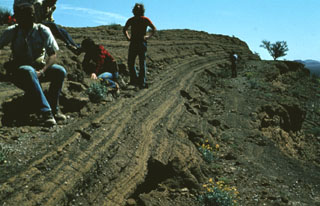 A group of geologists observe bedded pyroclastic surge deposits from the Cerro Colorado maar. Thinly bedded surge units are typical of distal portions of pyroclastic surge deposits, caused by deposition of material from the basal part of the flow.
A group of geologists observe bedded pyroclastic surge deposits from the Cerro Colorado maar. Thinly bedded surge units are typical of distal portions of pyroclastic surge deposits, caused by deposition of material from the basal part of the flow.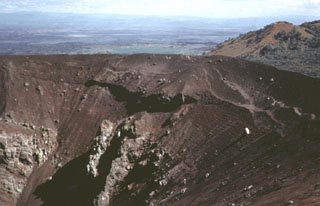 Volcán Tecolote is one of the youngest scoria cones of the Pinacate volcanic field and is located NE of Cráter Elegante. This complex cone contains faults and small craters, opens towards the NW, and was constructed on top of the Mayo cone. Large volcanic bombs, some with cores of older volcanic and non-volcanic rocks, are scattered across the southern and east crater rims and southern flanks. Six basaltic ‘a’a lava flows extend from the base of the cone.
Volcán Tecolote is one of the youngest scoria cones of the Pinacate volcanic field and is located NE of Cráter Elegante. This complex cone contains faults and small craters, opens towards the NW, and was constructed on top of the Mayo cone. Large volcanic bombs, some with cores of older volcanic and non-volcanic rocks, are scattered across the southern and east crater rims and southern flanks. Six basaltic ‘a’a lava flows extend from the base of the cone. Santa Clara shield volcano, seen on the SW horizon beyond the rim of Cráter Elegante maar, is of late-Pliocene to Pleistocene age. The broad edifice is largely mantled by pyroclastic ejecta and lava flows of the basaltic Pinacate monogenetic volcanic series, which began erupting about 1.2 million years ago. More than 500 scoria cones and associated lava flows have formed across the Pinacate field and extend into the surrounding desert.
Santa Clara shield volcano, seen on the SW horizon beyond the rim of Cráter Elegante maar, is of late-Pliocene to Pleistocene age. The broad edifice is largely mantled by pyroclastic ejecta and lava flows of the basaltic Pinacate monogenetic volcanic series, which began erupting about 1.2 million years ago. More than 500 scoria cones and associated lava flows have formed across the Pinacate field and extend into the surrounding desert.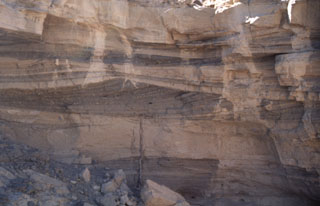 Pyroclastic surge deposits exposed in gullies on the flanks of Cráter Elegante in the Pinacate volcanic field of NW México. This photo shows cross bedding produced by particles transported by saltation or dilute suspension in a high-velocity pyroclastic surge. The direction of movement of the surge cloud, seen by the truncation of dune beds on the near-vent side, was from right to left. This type of bedding is common in areas near the rim of the maar.
Pyroclastic surge deposits exposed in gullies on the flanks of Cráter Elegante in the Pinacate volcanic field of NW México. This photo shows cross bedding produced by particles transported by saltation or dilute suspension in a high-velocity pyroclastic surge. The direction of movement of the surge cloud, seen by the truncation of dune beds on the near-vent side, was from right to left. This type of bedding is common in areas near the rim of the maar.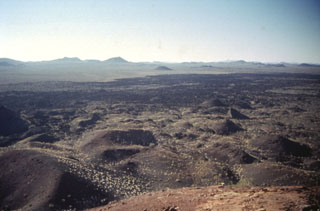 More than 500 basaltic scoria cones and associated lava flows dot the Pinacate volcanic field, visible here near Cerro Colorado. The field also contains maars like Cerro Colorado and the large basaltic-to-trachytic Santa Clara shield volcano.
More than 500 basaltic scoria cones and associated lava flows dot the Pinacate volcanic field, visible here near Cerro Colorado. The field also contains maars like Cerro Colorado and the large basaltic-to-trachytic Santa Clara shield volcano.Maps are not currently available due to technical issues.
The following 10 samples associated with this volcano can be found in the Smithsonian's NMNH Department of Mineral Sciences collections, and may be availble for research (contact the Rock and Ore Collections Manager). Catalog number links will open a window with more information.
| Catalog Number | Sample Description | Lava Source | Collection Date |
|---|---|---|---|
| NMNH 117630-1 | Basalt | Volcán La Morusa | -- |
| NMNH 117630-10 | Basalt | -- | -- |
| NMNH 117630-2 | Basalt | -- | -- |
| NMNH 117630-3 | Basalt | -- | -- |
| NMNH 117630-4 | Basalt | Crater Elegante | -- |
| NMNH 117630-5 | Basalt | Crater Elegante | -- |
| NMNH 117630-6 | Basalt | Crater Elegante | -- |
| NMNH 117630-7 | Basalt | Crater Elegante | -- |
| NMNH 117630-8 | Basalt | -- | -- |
| NMNH 117630-9 | Basalt | -- | -- |
| Copernicus Browser | The Copernicus Browser replaced the Sentinel Hub Playground browser in 2023, to provide access to Earth observation archives from the Copernicus Data Space Ecosystem, the main distribution platform for data from the EU Copernicus missions. |
| MIROVA | Middle InfraRed Observation of Volcanic Activity (MIROVA) is a near real time volcanic hot-spot detection system based on the analysis of MODIS (Moderate Resolution Imaging Spectroradiometer) data. In particular, MIROVA uses the Middle InfraRed Radiation (MIR), measured over target volcanoes, in order to detect, locate and measure the heat radiation sourced from volcanic activity. |
| MODVOLC Thermal Alerts | Using infrared satellite Moderate Resolution Imaging Spectroradiometer (MODIS) data, scientists at the Hawai'i Institute of Geophysics and Planetology, University of Hawai'i, developed an automated system called MODVOLC to map thermal hot-spots in near real time. For each MODIS image, the algorithm automatically scans each 1 km pixel within it to check for high-temperature hot-spots. When one is found the date, time, location, and intensity are recorded. MODIS looks at every square km of the Earth every 48 hours, once during the day and once during the night, and the presence of two MODIS sensors in space allows at least four hot-spot observations every two days. Each day updated global maps are compiled to display the locations of all hot spots detected in the previous 24 hours. There is a drop-down list with volcano names which allow users to 'zoom-in' and examine the distribution of hot-spots at a variety of spatial scales. |
|
WOVOdat
Single Volcano View Temporal Evolution of Unrest Side by Side Volcanoes |
WOVOdat is a database of volcanic unrest; instrumentally and visually recorded changes in seismicity, ground deformation, gas emission, and other parameters from their normal baselines. It is sponsored by the World Organization of Volcano Observatories (WOVO) and presently hosted at the Earth Observatory of Singapore.
GVMID Data on Volcano Monitoring Infrastructure The Global Volcano Monitoring Infrastructure Database GVMID, is aimed at documenting and improving capabilities of volcano monitoring from the ground and space. GVMID should provide a snapshot and baseline view of the techniques and instrumentation that are in place at various volcanoes, which can be use by volcano observatories as reference to setup new monitoring system or improving networks at a specific volcano. These data will allow identification of what monitoring gaps exist, which can be then targeted by remote sensing infrastructure and future instrument deployments. |
| Volcanic Hazard Maps | The IAVCEI Commission on Volcanic Hazards and Risk has a Volcanic Hazard Maps database designed to serve as a resource for hazard mappers (or other interested parties) to explore how common issues in hazard map development have been addressed at different volcanoes, in different countries, for different hazards, and for different intended audiences. In addition to the comprehensive, searchable Volcanic Hazard Maps Database, this website contains information about diversity of volcanic hazard maps, illustrated using examples from the database. This site is for educational purposes related to volcanic hazard maps. Hazard maps found on this website should not be used for emergency purposes. For the most recent, official hazard map for a particular volcano, please seek out the proper institutional authorities on the matter. |
| IRIS seismic stations/networks | Incorporated Research Institutions for Seismology (IRIS) Data Services map showing the location of seismic stations from all available networks (permanent or temporary) within a radius of 0.18° (about 20 km at mid-latitudes) from the given location of Pinacate. Users can customize a variety of filters and options in the left panel. Note that if there are no stations are known the map will default to show the entire world with a "No data matched request" error notice. |
| UNAVCO GPS/GNSS stations | Geodetic Data Services map from UNAVCO showing the location of GPS/GNSS stations from all available networks (permanent or temporary) within a radius of 20 km from the given location of Pinacate. Users can customize the data search based on station or network names, location, and time window. Requires Adobe Flash Player. |
| DECADE Data | The DECADE portal, still in the developmental stage, serves as an example of the proposed interoperability between The Smithsonian Institution's Global Volcanism Program, the Mapping Gas Emissions (MaGa) Database, and the EarthChem Geochemical Portal. The Deep Earth Carbon Degassing (DECADE) initiative seeks to use new and established technologies to determine accurate global fluxes of volcanic CO2 to the atmosphere, but installing CO2 monitoring networks on 20 of the world's 150 most actively degassing volcanoes. The group uses related laboratory-based studies (direct gas sampling and analysis, melt inclusions) to provide new data for direct degassing of deep earth carbon to the atmosphere. |
| Large Eruptions of Pinacate | Information about large Quaternary eruptions (VEI >= 4) is cataloged in the Large Magnitude Explosive Volcanic Eruptions (LaMEVE) database of the Volcano Global Risk Identification and Analysis Project (VOGRIPA). |
| EarthChem | EarthChem develops and maintains databases, software, and services that support the preservation, discovery, access and analysis of geochemical data, and facilitate their integration with the broad array of other available earth science parameters. EarthChem is operated by a joint team of disciplinary scientists, data scientists, data managers and information technology developers who are part of the NSF-funded data facility Integrated Earth Data Applications (IEDA). IEDA is a collaborative effort of EarthChem and the Marine Geoscience Data System (MGDS). |